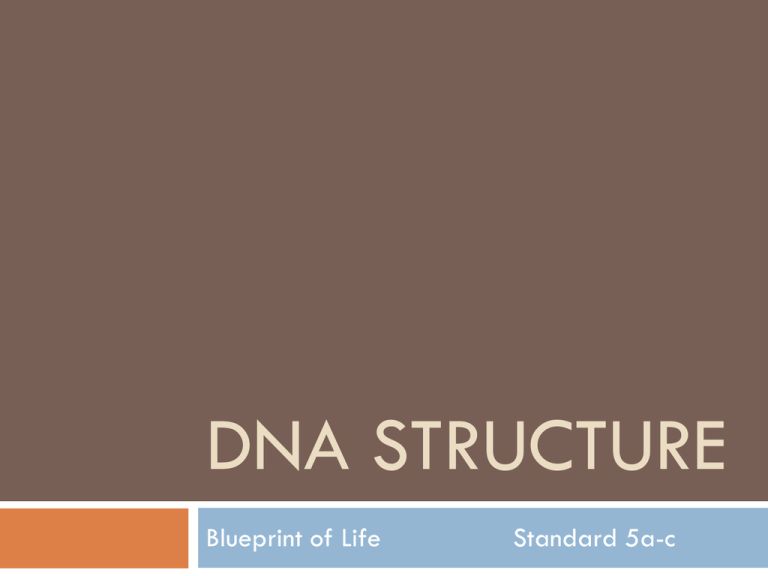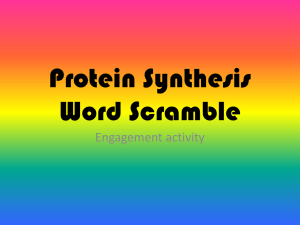
DNA STRUCTURE
Blueprint of Life
Standard 5a-c
5a. DNA & RNA
DNA is a double helix made of a sugarphosphate backbone with complimentary
bases paired in middle
Nucleotide (sugar, phosphate, & base)
A pairs with T
C pairs with G
RNA vs. DNA
Difference
DNA
RNA
# of Strands
Double
Single
Bases
thymine
uracil
Sugar
Deoxyribose
Ribose
Questions
1. The monomers that are put together to make
nucleic acids are called:
A)
Nucleotide
B) Phosphate
C) Base
D) Sugar
A. Nucleotides
2. DNA & RNA are made up of which type of macromolecule?
A) Carbohydrate
B) Lipids
C) Nucleic Acids
D) Proteins
C. Nucleic Acids
DNA
-________ stranded
- ____________ (sugar)
- thymine (nitrogenous base)
RNA
- ______ stranded
- _______ (sugar)
- _____ (nitrogenous base
1. DNA or RNA?
2. Identify the bases in strand B
GTGACC
5b. DNA Replication
DNA Replication makes a copy
of DNA before cell division
(mitosis or meiosis)
DNA replication is semiconservative
Each
parent strand is a template
for new daughter strand.
DNA has anti-parallel strands
They
run in opposite directions
Enzymes carry out replication
1)
Helicase – unzips DNA
2) Primase – starts replication
3) Polymerase – matches A-T, C-G
to make new strands
4) Ligase – glues lagging strand
fragments together
Question
What does semi-conservative mean?
A)
Strands are anti-parallel.
B) The old strands serve as templates for the new DNA.
C) The old strands are lost.
B. Old strand is conserved
What enzyme matches DNA base pairs (A-T, C-G)?
A) Helicase
B) Primase
C) Polymerase
D) Ligase
C. Polymerase
5c. Genetic Engineering
Recombinant DNA contains DNA from 2+
organisms.
Restriction enzymes cut out gene from
DNA
Vectors (bacteria & viruses) can be used
to insert new gene into cell.
Uses:
1) Make medicines
Ex: insulin, human growth hormone
2) Food Crops
Ex: pest-resistant, larger fruits/veggies
PROTEIN SYNTHESIS
DNA > mRNA > ribosome > protein
Standard 4a & b
4a. Protein Synthesis
Protein Synthesis = making proteins
1. Transcription = DNA > mRNA
DNA is transcribed (copied) into
messenger RNA (mRNA) to leave
the nucleus
DNA is too big, it does not leave
the nucleus
mRNA carries the info in DNA out
of the nucleus to the ribosomes in
the cytoplasm
4a. Protein Synthesis
2. Translation = mRNA > protein
mRNA is translated into a protein by
a ribosome
Codon = 3 letter “words” on mRNA
Ex. U G G
UCA
AUC
Transfer RNA (tRNA) matches each
codon and transfers the correct
amino acids
Amino acids add together to make
a polypeptide chain, which becomes
a protein
4b. Build a Protein
1. Transcription DNA > mRNA
Base
Pairing Rules
DNA:
mRNA:
A-T C-G
A-U C-G
Transcribe the DNA template strand into mRNA
DNA :
C T G T A C G G A template strand
mRNA:
G ACAUGCCU
A base sequence of DNA is shown below.
ACAGTGC
How would the base sequence be coded on mRNA?
A) TGTCACG
B) GUGACAU
C) UGUCACG
D) CACUGUA
4b. Build a Protein
2. Translation:
mRNA > protein
Use the codon
table
Codon
AUG
UGU
ACG
GAC
UAA, UAG,
UGA
Amino Acid
MUTATIONS &
PROTEINS
Changes in DNA
std. 4c-e
4c. Mutations
Mutation = permanent change in the DNA
base sequence
Mutations can be good, neutral, or bad
1.Single
base change – may or may not have an
effect (ex: A C)
What would happen if GGG changed to GGC?
both=
What
Gly so nothing…
would happen if UAC changed to UAG?
stops
protein production so effect could be major…
2. An insertion or deletion changes the reading “frame”
The fat cat ate the rat
The atc ata tet her at
Major effects!
Mutations occurs in sperm or egg – passed to offspring
= disease
Tay Sachs disease, sickle-cell anemia, muscular dystrophy
Mutations occurs in regular body cells they may cause
cancer
4d. Cell Specialization
All cells in your body have the SAME DNA
Only genes need by that cell are
expressed.
Each cell only expresses the portion of the
DNA containing the genetic information
for the proteins required by that cell at
that time.
The remainder of the DNA is not
expressed
Example:
The cells of in your skin have the DNA that
codes for your eye color protein. They just
don’t use it
4e. Proteins
20 amino acids make up all proteins.
Your body creates many different proteins by changing
the number and sequence of amino acids
Proteins vary from about 50 to 3,000 amino acids in
length.
The types, sequences, and numbers of amino acids used
determine the type of protein produced.
Hemoglobin – 574 aa
Insulin – 51aa
One human disease is caused by a change in one
codon in a gene from GAA to GUA. This disease
is the result of:
A a mutation.
B a meiosis error.
C crossing-over.
D polyploidy.
Although there are a limited number of amino acids, many different
types of proteins exist because the
A. size of a given amino acid can vary.
B. chemical composition of a given amino acid can vary.
C. sequence and number of amino acids is different.
D. same amino acid can have many different properties.
Mutations within a DNA sequence are:
A. natural processes that produce genetic diversity.
B. natural processes that always affect the
phenotype.
C. unnatural processes that always affect the
phenotype.
D. unnatural processes that are harmful to genetic
diversity.
CHROMOSOMES
Wound up DNA
Standard 2e-f
2e. Chromosomes
Write really small!!!
Chromosome - wound-up
DNA containing genes
Sister chromatids are
identical copies held
together by a centromere
Draw & label a chromosome
on the right margin.
2e. Homologous Chromosomes
Homologous chromosomes – have the SAME genes
at the SAME locations
One
came from mom, one from dad
2f. Sex-determination
Karyotype – chart shows all the homologous pairs
Autosomes
- pairs 1-22
Sex chromosomes - 23rd pair determines sex
XX
= girl
XY = boy
Questions
True or False:
1) Humans have 46 chromosomes
2) Humans have 23 pairs of chromosomes
3) Pairs 1-23 are autosomes
4) XX is male
5) XY is male
6) Sister chromatids are copies of each other.
7) Homologous chromosomes are identical.
MEIOSIS
Making Sex Cells
std. 2a-d, 2g
2a. Chromosome Number
Divide Box 2a into 2 columns (5 concepts to write, 3 in left column, 2 in right)
1. Chromosome Number
Diploid (2n) – somatic (body) cells with
2 sets of homologous chromosomes
Humans = 46 chromosomes (23 pairs)
Haploid (n) – gamete sex cells that
have 1 set of chromosomes
Humans = 23 single chromosomes
Questions
1) A bug has a haploid number n=5. What is the
diploid number (2n)?
2) A crocodile has a diploid number 2n=50. What is
the haploid number (n)?
Diploid
2n
meiosis
n
Haploid gamete
meiosis
n
Haploid gamete
2a. Meiosis Overview
2. Meiosis vs. Mitosis
Meiosis – cell division specific to sexual reproduction
that results in 4, genetically different, haploid
gamete (sex) cells
23
23
Zygote
46
First cell of a new
organism
Mitosis – asexual cell division that results in 2,
genetically identical, diploid cells
Questions
A = Mitosis
B = Meiosis
C = Both
1) Type of cell division.
2) Produces 2 cells
3) Produces 4 cells
4) Sexual reproduction
5) Asexual reproduction
6) Resulting cells are genetically different
7) Diploid to haploid
8) Resulting cells are genetically identical
9) Diploid to Diploid
1) C
2) A
3) B
4) B
5) A
6) B
7) B
8) A
9) B
2a. Steps of Meiosis
3. Steps of Meiosis
Steps are mostly the same as Mitosis, but diploid cell
divides twice
Meiosis I separates the homologous pairs
Meiosis II separates sister chromatids
Steps of Meiosis
2a. Crossing Over
4. Crossing Over
Homologous chromosomes pair up
and randomly trade piece of DNA
during Prophase I
This creates genetic variation (new
gene combinations that never
existed before)
Draw Crossing Over (middle step
in diagram)
2a. Independent Assortment
5. Independent Assortment
Genes for different traits sort independently into
gametes
Genes on different chromosomes are not connected
Ex: The gene for eye
color is not connected
to the gene for hair
color.
Questions
What accounts for so many possible combinations of
genes in gametes?
A)
Crossing-over
B) Independent Assortment
C) Both of these
C. Both
True or False:
Meiosis 1 separates homologous pairs, while Meiosis
II separates sister chromatids.
True!
2b. Meiosis in Humans
Only gonads undergo meiosis
MALES
= the testis produces 4 sperm (gametes)
FEMALES = the ovaries produces 1 large egg (gamete)
and 3 polar bodies
2c. Random Segregation
Law of Segregation
It is random whether the gamete gets the maternal
or paternal version of each trait
Each gamete only gets one allele
Draw the diagram:
Ex: If a pea plant is tall (Tt), half the gametes
will have T and the other half will have t.
After fertilization, the offspring will have 2
alleles, one from mom & one from dad
If a corn plant has a genotype of Ttyy, what are
the possible genetic combinations that could be
present in a single grain of pollen from this plant?
A. Ty, ty
B. TY, ty
C. TY, Ty, ty
D. Ty, ty, tY, TY
2d. Fertilization
Fertilization:
Sperm + egg = zygote
(23) (23)
(46)
haploid + haploid = diploid
n
+
n
= 2n
2g. Predicting Offspring
Alleles - different versions
of a trait
Ex:
Blue or brown eyes
Knowing the alleles of the
parents allows you to
predict the possible traits of
the offspring.
Use a Punnett Square
Questions
True or False?
1) Segregation occurs when genes separate into
gametes.
2) Females produce 4 eggs.
3) Males produce 4 sperm.
4) Fertilization occurs when diploid eggs and sperm
make a zygote.
5) Human zygotes have 23 chromosomes.
6) Alleles are different versions of a trait.
PUNNETT SQUARES
Predicting Inheritance
Standard 3a & b
3a. Punnett Squares
Vocabulary to know:
Genotype = genes (TT, Tt, tt)
Phenotype = appearance (Tall or short)
Homozygous/Purebred = 2 of the same allele (TT or tt)
Heterozygous/Hybrid = 2 different alleles (Tt)
Types of Inheritance
1. Autosomal – genes on regular
body chromosomes (#1-22)
Dominant covers up recessive
ex:
Bb
The protein created by the
dominant gene functions better
or is darker/stronger than the
recessive protein
2. Incomplete & Codominance
Incomplete
dominance = show
mix/blend between two alleles
Ex:
Red + White = pink
Codominance = show both
traits at once
Ex:
Red + White = red & white
stripes
3. Sex-linked – genes on
X-chromosome
Because
men have only 1
X (XY) they don’t have a
“backup” X like women
(XX) to hide the trait
If the X is bad, men have
the disease
Colorblindness,
hemophilia
3b. Mendel’s Laws (see 2a & c)
Mendel’s Law of Segregations – see 2c
Mendel’s Law of Independent Assortment – see 2a5








